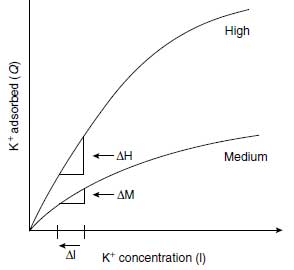Soil Tests for Potassium Fertilizer Recommendations
The most common test for available K+ is the exchangeable K+ obtained by extraction with 1M NH4Cl or NH4 acetate. This fraction contains mainly soil solution K+ plus K+ of the hydrated K+fraction and only a small part of the interlayer K+. Exchangeable K+ ranges between 40 and about 400 mg/kg soil and even more. Concentrations of <100 mg K/kg are frequently in the deficiency range; concentrations between 100 and 250 mg K/kg soil are in the range of sufficiently to well-supplied soils.Since one cannot distinguish between interlayer K+ and K+ from the hydrated fraction, this test gives no information about the contribution of interlayer K+. The interpretation of the exchangeable soil test data therefore requires some information about further soil parameters, such as clay concentration and type of clay minerals. But even if these are known, it is not clear to what degree the interlayer K+ is exhausted and to what degree mica of the silt fraction contributes substantially to the crop supply (90). Available K+ is determined also by extraction with 1 mM HCl, by which the exchangeable K+ and some of the interlayer K+ are removed. Furthermore, with this technique the contribution of the interlayer K+ also is not determined. The same is true for soil extraction with a mixture of 0.25 mM Ca lactate and HCl at a pH of 3.6 (108). Quantities of K+ extracted with this technique are generally somewhat lower than the quantities of the exchangeable K+ fraction.
 |
| FIGURE 4.12 Potassium buffer power of a soil with a high or a medium buffer power [quantity-intensity (Q/I) ratio]. |
With the EUF technique, a differentiation between the nonhydrated exchangeable K+ and the interlayer K+ is possible, as shown in Figure 4.10. In the EUF, routine analysis extraction of the adsorbed hydrated K+ lasts 30 minutes (200V, 20�C); for the second fraction (400V, 80�C), the soil suspension is extracted for only 5 minutes. The K+ extracted during this 5-minute period is a reliable indicator of the availability of interlayer K+ and is taken into consideration for the recommendation of the potassium fertilization rates. This EUF technique is nowadays used on a broad scale in Germany and Austria with much success for the recommendation of K fertilizer rates, particularly to crops such as sugar beet (109). With the EUF extraction procedure, not only are values for available K+ obtained but the availability of other plant nutrients such as inorganic and organic nitrogen, phosphorus, magnesium, calcium, and micronutrients are also determined in one soil sample.




